
Article contents

If you’re self-employed, you’ll need to save into a personal pension, which is simply a pension you set up yourself. You’ll automatically get a 25% bonus from the government on everything you save, and you can claim back 40% or 45% tax if you’ve paid it. Your pension will also grow tax-free too (you might pay tax when you withdraw it).
Self-employed and not sure how the government contributions work? You’re in the right place. And by the way, they’re pretty great contributions. Let’s run through everything.
Did you know that saving into a pension is intended to be tax-free? (whoop!). If you’re self-employed, you don’t have an employer to handle things for you (such as set up your pension, and take your contributions out of your salary before you pay tax), you need to handle things yourself (but don’t worry, it’s really easy).
Instead of your money going into your pension straight from your pay, tax-free, like a work pension – which is a pension that your employer will set up for you if you’re employed, and take your pension contributions directly from your pay and put them into your pension...
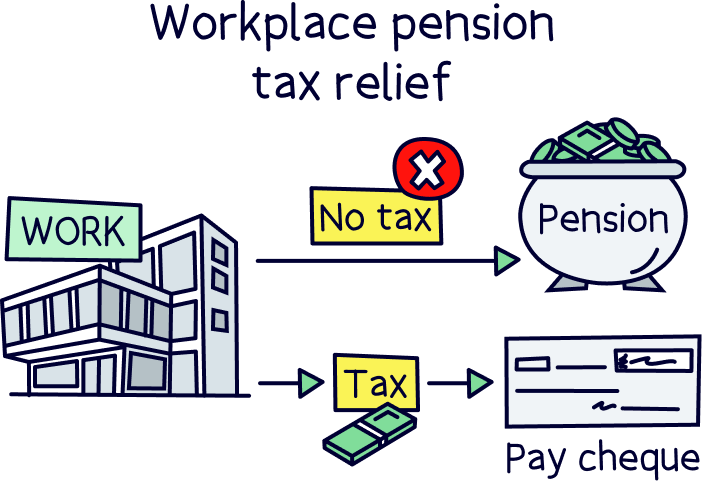
Once you’ve set up a personal pension, and start saving into it, you’ll receive a massive 25% bonus on all the money you add (up to a limit, more on that below). This is all handled automatically, and will simply turn up in your account after a few weeks. How great is that?
That means your pension contributions become completely tax-free, as this refunds any tax that you’ll have to pay through your Self Assessment tax return (which is a form to tell the government how much tax you’re due to pay each year, either completed by yourself, or your accountant if you have one).
The 25% government contribution refunds the tax paid at the 20% tax rate, called the basic rate of tax (the maths seems odd, but it works out).
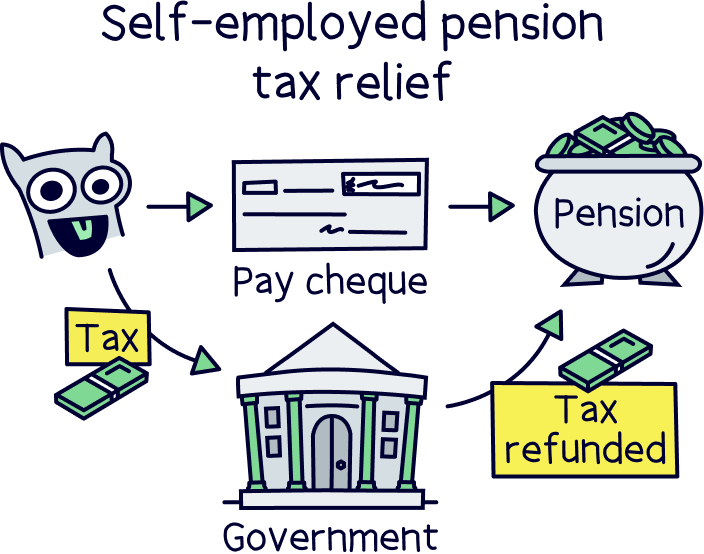
Anything you earn up to £50,270 is taxed at 20%, apart from your personal allowance, which is the first £12,570 you earn, each tax year (April 6th to April 5th the following year).
After £50,270 in earnings, you’ll pay 40% tax on everything up to £125,140, and then 45% on everything above that.
Now you might be thinking, if you earn over £50,270 you won’t get the full amount of tax back as the government pension contribution is only 25%. Well, don’t fret – you’ll still get the tax back if you earn above that, it just works a bit differently…
Instead of the government contributing the full amount of tax paid (40% or 45%) directly into your pension (they’ll refund the 20% tax automatically), you’ll simply need to tell the government on your Self Assessment tax return, that you’ve made contributions into your pension, and then this will reduce your tax bill to refund you any tax paid at 40% or 45%. Need help with your tax return? Taxfix¹ can help you, their service is rated 5 stars.
Nuts About Money tip: if you are a higher earner, your pension is one of the best places to reduce tax, while also being a great way to save for your future. It’s a win-win.
It all works out quite nicely right? Meaning you can save into your pension tax-free, pretty much like an employee, and build up a nice pension pot already for a comfortable retirement.
There is some bad news though, your pension pot needs to be pretty big these days. In fact, for a comfortable retirement income of £43,100 per year, you’ll need a whopping £853,039 in your private pension pot (your self-employed pension pot). And that figure includes you getting the State Pension (the government pension, more on that in a bit). We’ll cover how much you’ll need just below too.
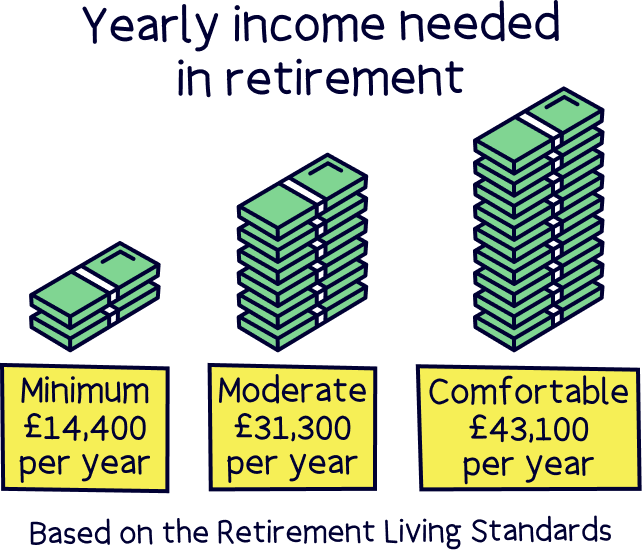
Not got a self-employed pension yet, and want to benefit from those juicy government contributions? It really is a great idea to get a pension as soon as you can, and keep saving into it as much as possible (ideally monthly). It’s the best way to build up a nice big pension pot to give you the retirement you deserve.
Here’s how to set up a pension if you’re self-employed:
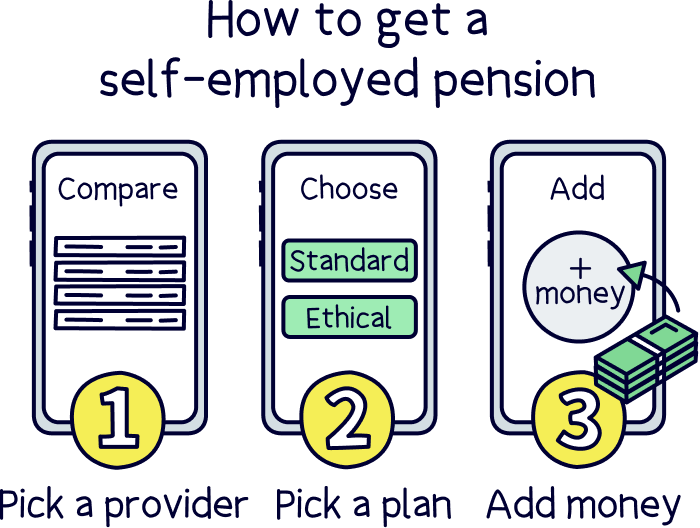
If you’re self-employed, it’s all down to you to find a pension provider. You’ll need a personal pension, which is a type of private pension, which simply means a pension that’s all yours (private to you). Another type of private pension is called a workplace pension, you'll get this if you're employed.
We’ve done the hard work for you here, and reviewed all the best pension providers for those self-employed. We’ve focused on how easy they are to set up and use, if it’s low cost, and whether you can pay in from a limited company (if you have one).
We recommend PensionBee if you’re self-employed, it’s easy to use, has low fees, and a great record of growing pensions.
Get £50 added to your pension



PensionBee is our recommended provider – they’ve thought of everything.
Their 5 star rated app (and website) makes it easy to set up and use. You can open a brand new pension, or transfer your existing pensions across (they’ll handle all the paperwork).
Simply pick from an easy to understand range of pension plans, and that’s it, the experts manage everything from there.
It’s low cost, with one simple annual fee. The customer service is excellent, and you’ll get a dedicated account manager for any questions you might have.

And, when the time comes to retire, withdrawing from your pension is easy too.
You can also use them if you're self-employed or a company director.
Great app



A great and easy to use pension. Add money from your bank or combine old pensions into one, (they’ll find lost pensions too).
The customer service is excellent, with support based in the UK.

Beach is an easy to use pension app (and easy to set up), where you just add money and the experts handle everything. It’s all managed on your phone with a great app, and you can see your total pension pot whenever you like.
If you’ve got lost or old pensions, Beach can also find them and move them over too, so you can keep all your retirement savings in one place, and never have to worry about losing them in future.
You’ll get an automatic 25% bonus on the money you add to your pension pot from your bank account (tax relief from the government), which refunds 20% tax on your income, and if you pay 40% or 45% tax, you’ll typically be able to claim the extra back too.
The pension plan (investments) are managed by experts, who are the largest investment company in the world (BlackRock). And they consider things like reducing climate change, meaning your savings could make the world a little better in future too.
You can also save and invest alongside your pension with an easy access pot (access money in around a week), designed for general savings, with the investments managed sensibly by experts too. And money made can be tax-free within an ISA.
Fees: a simple annual fee of up to 0.73% (minimum £3.99 per month).
Minimum deposit: £25
Customer service: excellent
Pros:
Cons:
We recommend PensionBee if you’re self-employed, it’s easy to use, has low fees, and a great record of growing pensions.
Nuts About Money tip: for all your options, and to learn more, check out our guide to the best private pensions for the self-employed.
Once you’re all set with a pension provider, next is deciding which pension plan you’d like. With our top providers above, there’s a few easy to understand options to choose from, and that’s it, you’re all set.
There should be one option to suit you, there’s usually an option to save your money ethically (such as not investing in fossil fuel companies), or you can opt for the standard option. (You can always change your mind later.)
Now simply add some money and you’re all set. It’s a great idea to set up a monthly top up if you can afford it, that way it can grow nice and big over time and you won't forget to add to it.
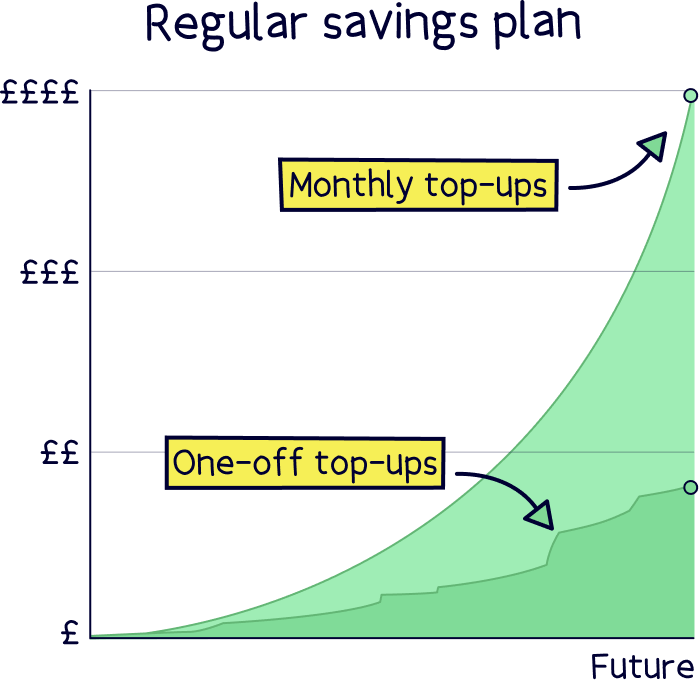
We know this can be difficult for a lot of self-employed people, where income isn’t always guaranteed or regular, but just putting a little bit away each month can really have a big impact later down the line. You can always add more if you have a good month.
Before you go rushing off saving all your money into a pension, there are a few limits to be aware of…
The first is that you can only save as much as your yearly income each tax year, and that’s the income you pay yourself as a salary, rather than dividends (paying profits from your company to yourself).
Or, you can save up to £60,000 per year, whichever is the lower of the two.
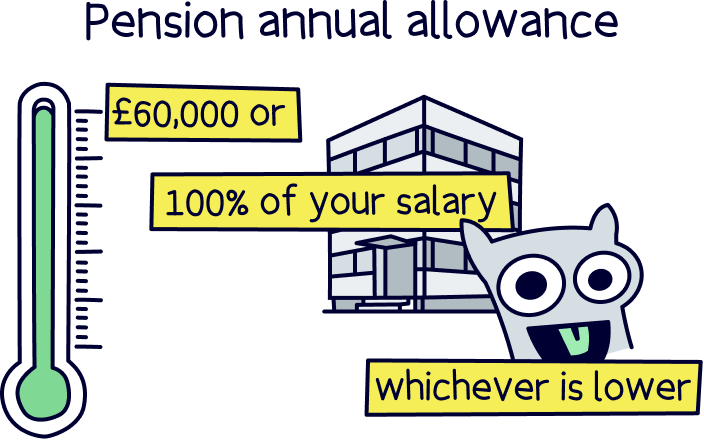
Nuts About Money tip: if you are a limited company director, you can save even more in tax by paying into your pension through your company, rather than directly yourself. And, your limit is always £60,000, you can ignore the salary limit. Learn more with our guide to self-employed pensions.
The second limit is that you’ll only be able to access your money after the age of 55 (57 from 2028). It is for retirement after all. Although it’s often a good idea to keep it saved until you really retire, so it can grow much bigger over time, and provide a bigger retirement income (we’ll run through how much you’ll need below).
These days you’ll need a pretty hefty pension pot to provide enough money to live on in retirement, but luckily, pensions are pretty great at growing over time, and you’ve got all the lovely government contributions to help you too.
As general guidance, there’s 3 key levels of retirement income, minimum, moderate and comfortable…
The minimum just covers the basics, such as food and essential bills. Moderate is more for food and bills, and a cheap holiday each year. And comfortable is well, being able to live comfortably, with more for food and bills, and a new(ish) car.
Nuts About Money tip: here’s where to learn more about the Retirement Living Standards.
As an overview, here’s how much you need:
Note: this is in addition to the full State Pension.
Quite a lot right? But don’t panic, once your money is in a pension, it can grow very large over time. As you know, you’ll get a massive 25% bonus from the government on everything you save, but your money will also grow tax-free too – so it can grow even quicker over time, and there’s no paperwork to worry about each year either.
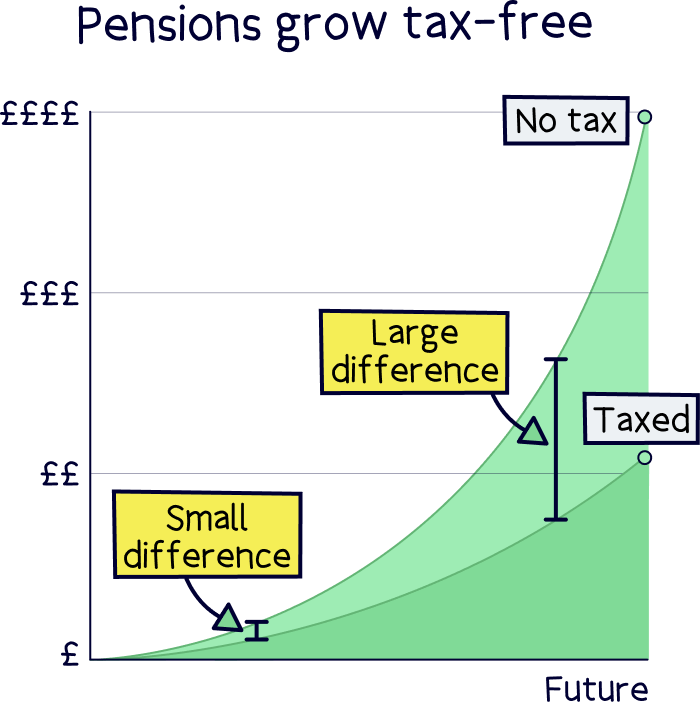
Note: you may pay tax when you withdraw it, it all depends on your income at the time. Your pension acts similar to your income now, so you’ll pay Income Tax on it if it’s over £12,570 per year. However, 25% will be completely tax-free when withdrawing.
Let’s use an example to show how your pensions can really grow big over time. Imagine you already had a pension pot of £10,000, and were able to save £220 per month, and your pension grew by 7% per year on average.
After 25 years, your pension would have grown to a massive £235,470. And another 10 years after that, it would have nearly doubled to £511,294. Just one more year after that, and you’d earn £35,791 in one year. Pretty great right?
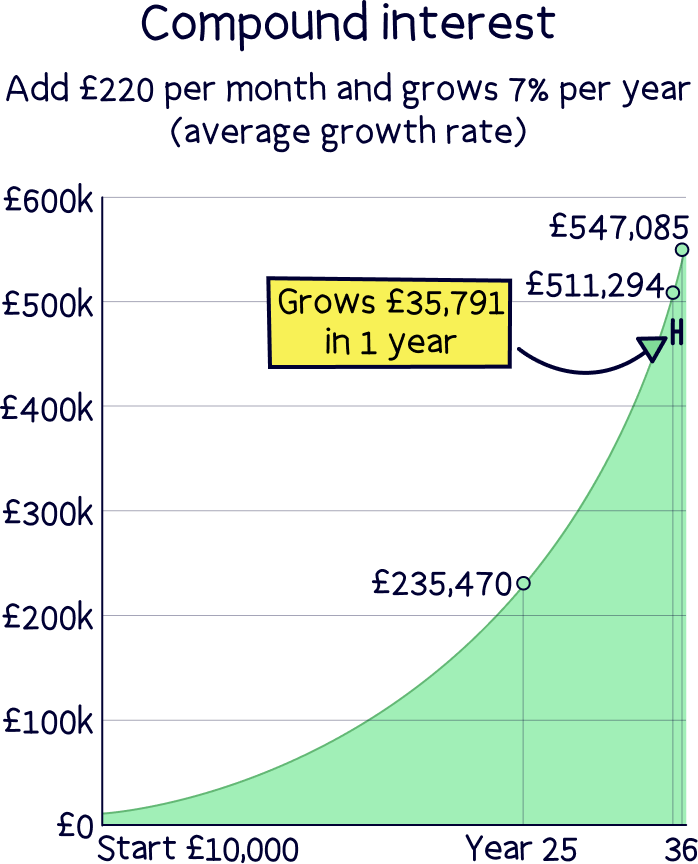
The important thing is to start saving as soon as you can, and ideally save monthly, so it can build up without you thinking about it.
If you’re not sure where to get started with a pension, check out PensionBee¹, it’s easy to use, has low fees and a great track record of growing pensions over time. Plus, we’ve managed to bag you £50 added to your pension if you sign up with Nuts About Money.
Self-employed people can also get the State Pension, which is the government pension, that you’ll get when you reach State Pension age (currently 66), and if you’ve paid enough National Insurance contributions over your working life – you’ll need to make at least 10 years worth, but 35 years for the full amount.
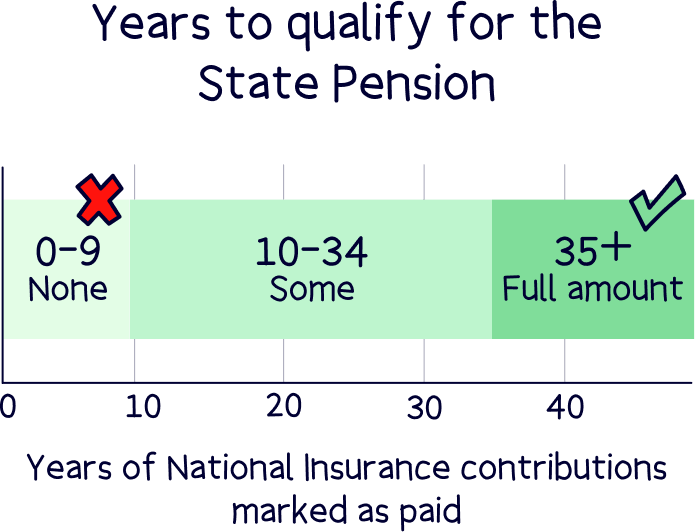
However, the full amount is only £230.25 per week, which is £11,973 per year. So it’s not a lot, in fact, it’s not really enough to live on – and you shouldn’t rely on this. Ideally, you’d want a very large private pension pot too, to give you the comfortable retirement you deserve.
If you’re self-employed, but also run your business through a limited company, you’re in for a treat. You’ll actually be able to save even more tax.
You can do this by paying into your pension from your company (business bank account), which would be a business expense, and so reduce your Corporation Tax bill. So you could end up saving as much as another 25% on your pension contributions.
You’ll still get all the same benefits, such as tax-free saving. In fact, you won’t need to get the 25% government bonus (and you won’t automatically get it if you’re paying in from your company), or need to claim back any higher rate tax if you’ve paid it, as you won’t be paying tax on your contributions in the first place (money would go into your pension pot tax free directly from your company).
Pretty great right? All you need to do is set up your pension with a pension company who allows top ups from your company and the business bank account. For that, we also recommend PensionBee¹, it’s easy to use overall, and easy to make top ups from your business account.
Or, for all your options, check out the best pensions for limited company directors.
By the way, if you’ve got any old pensions sitting around collecting dust, you’ll also be able to transfer these to your new pension provider (if you’re setting one up). This is called combining your pension, or consolidating your pension.
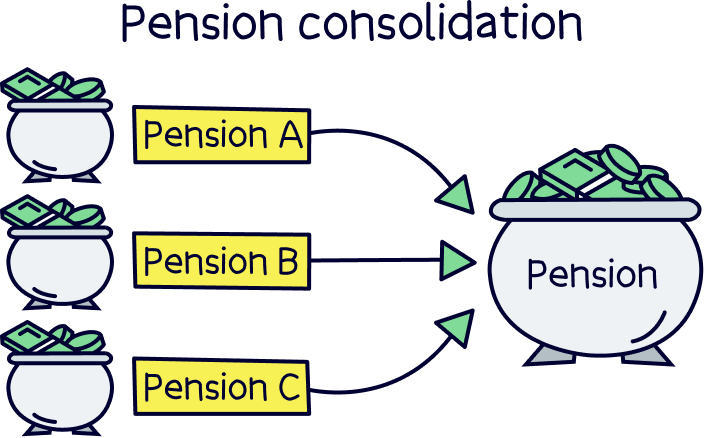
It’s often a good idea to do this, so you don’t forget about your old pensions when the time comes to retire (which happens a lot).
You’ll also have the reassurance your money is with a pension company that you’ve decided on – perhaps one that’s easy to use and has low fees. And, with all your pensions in one place, you can track and manage your total pension pot much easier, so you know how much you’ll need to keep saving to get the retirement you’d like.
It’s easy to combine your pensions too – a modern pension provider (such as Beach¹) will handle everything for you. All you need to do is let them know where your old pensions are, and they’ll handle the rest. Your money will simply turn up in your new pension pot after a few weeks (sometimes a few months).
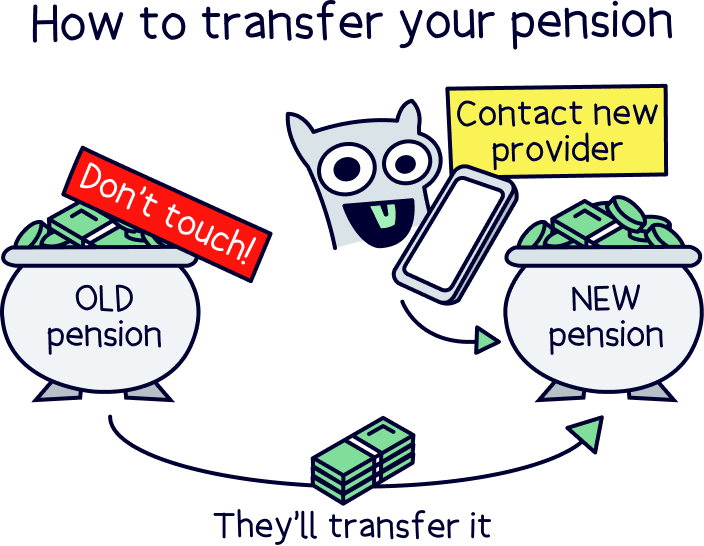
If you’re not sure where your old pensions are, try the government’s pension tracing service, or Gretel, a free online service to find lost pensions.
Right, there we have it, our guide to the self-employed pension government contribution. It’s all pretty promising right? Lots of free cash (well, tax-free saving) for self-employed people (and employed!).
You’ll get a massive 25% bonus from the government on all the money you save into your pension, and if you’re a higher rate (40%) or additional rate (45%) tax payer, you can claim some tax back at those rates too (on your Self Assessment tax return).
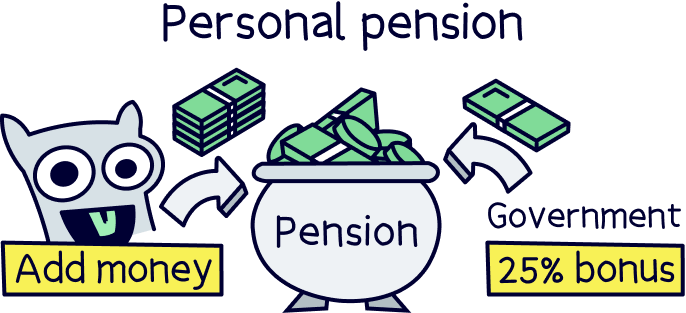
Your money will grow tax-free too, so it can grow much faster over time. And, you’ll even get 25% tax-free when you start to withdraw from it.
If you’re a limited company director, you’ll also be able to save up to an extra 25% tax (from your company tax), if you pay into your pension directly from your company.
Private pensions really are the best way to save for your retirement, especially if you’re self-employed – and technically, you’ll need to set up a personal pension.
If you’re not sure where to get started, we recommend checking out PensionBee¹. It’s perfect for the self-employed, easy to use, has low fees and a great record of growing pensions over time. You’ll also get £50 added to your pension for free with Nuts About Money.

And, for all the top options, check out the best private pensions.
And that’s it. All the best saving for your future (tax-free!).
We recommend PensionBee if you’re self-employed, it’s easy to use, has low fees, and a great record of growing pensions.
We recommend PensionBee if you’re self-employed, it’s easy to use, has low fees, and a great record of growing pensions.
We’d love to hear from you, and it will help others too.
We recommend PensionBee if you’re self-employed, it’s easy to use, has low fees, and a great record of growing pensions.